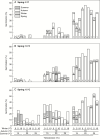Temporal patterns of seed germination in early spring-flowering temperate woodland geophytes are modified by warming
- PMID: 32055829
- PMCID: PMC7262466
- DOI: 10.1093/aob/mcaa025
Temporal patterns of seed germination in early spring-flowering temperate woodland geophytes are modified by warming
Abstract
Background and aims: Understorey species in temperate deciduous woodlands such as wild daffodil (Narcissus pseudonarcissus) and common snowdrop (Galanthus nivalis) have complex dormancy: seeds that are shed in late spring require warm summer temperatures for embryo elongation and dormancy alleviation, but then cooler temperatures for germination in autumn. As seasons warm and tree canopies alter, how will different seasonal temperature sequences affect these complex dormancy responses?
Methods: The effect of different sequences of warmer (+5 °C), current or cooler (-5 °C) seasons (summer to spring) on seed germination patterns over seven successive seasons were investigated, with all sequences combined factorially to determine the consequences of differential seasonal temperature change for the temporal pattern of germination (and so seedling recruitment).
Key results: Little (<1 %, G. nivalis) or no (N. pseudonarcissus) seed germination occurred during the first summer in any treatment. Germination of N. pseudonarcissus in the first autumn was considerable and greatest at the average (15 °C) temperature, irrespective of the preceding summer temperature; germination was also substantial in winter after a warmer autumn. Germination in G. nivalis was greatest in the warmest first autumn and influenced by preceding summer temperature (average > warmer > cooler); the majority of seeds that germinated over the whole study did so during the two autumns but also in year 2's cooler summer after a warm spring.
Conclusions: Warmer autumns and winters delay first autumn germination of N. pseudonarcissus to winter but advance it in G. nivalis; overall, warming will deplete the soil seed bank of these species, making annual seed influx increasingly important for recruitment and persistence. This study provides a comprehensive account of the effects of temperature changes in different seasons on seed germination in these early spring-flowering geophytes and consequently informs how these and other temperate woodland species with complex seed dormancy may respond to future climate change.
Keywords: Galanthus nivalis L; Narcissus pseudonarcissus L; Amaryllidaceae; climate change; daffodil; geophyte; morphophysiological dormancy; seed germination; snowdrop; temperate woodland; temperature.
© The Author(s) 2020. Published by Oxford University Press on behalf of the Annals of Botany Company. All rights reserved. For permissions, please e-mail: journals.permissions@oup.com.
Figures




Comment in
-
Unravelling change in forest ground floras. A commentary on: 'Temporal patterns of seed germination in early spring-flowering temperate woodland geophytes are modified by warming'.Ann Bot. 2020 Jun 1;125(7):iv. doi: 10.1093/aob/mcaa074. Ann Bot. 2020. PMID: 32476015 Free PMC article.
Similar articles
-
Seed development and maturation in early spring-flowering Galanthus nivalis and Narcissus pseudonarcissus continues post-shedding with little evidence of maturation in planta.Ann Bot. 2013 May;111(5):945-55. doi: 10.1093/aob/mct051. Epub 2013 Mar 10. Ann Bot. 2013. PMID: 23478943 Free PMC article.
-
Germination responses to winter warm spells and warming vary widely among woody plants in a temperate forest.Plant Biol (Stuttg). 2020 Nov;22(6):1052-1061. doi: 10.1111/plb.13152. Epub 2020 Aug 26. Plant Biol (Stuttg). 2020. PMID: 32594604
-
Temperature requirements for seed germination and seedling development determine timing of seedling emergence of three monocotyledonous temperate forest spring geophytes.Ann Bot. 2008 Nov;102(5):865-75. doi: 10.1093/aob/mcn165. Epub 2008 Aug 30. Ann Bot. 2008. PMID: 18757880 Free PMC article.
-
How Is Global Warming Affecting Fruit Tree Blooming? "Flowering (Dormancy) Disorder" in Japanese Pear (Pyrus pyrifolia) as a Case Study.Front Plant Sci. 2022 Feb 10;12:787638. doi: 10.3389/fpls.2021.787638. eCollection 2021. Front Plant Sci. 2022. PMID: 35211129 Free PMC article. Review.
-
The Role of Temperature in the Growth and Flowering of Geophytes.Plants (Basel). 2013 Nov 1;2(4):699-711. doi: 10.3390/plants2040699. Plants (Basel). 2013. PMID: 27137399 Free PMC article. Review.
Cited by
-
Unravelling change in forest ground floras. A commentary on: 'Temporal patterns of seed germination in early spring-flowering temperate woodland geophytes are modified by warming'.Ann Bot. 2020 Jun 1;125(7):iv. doi: 10.1093/aob/mcaa074. Ann Bot. 2020. PMID: 32476015 Free PMC article.
-
Experimental Warming Hastens Physical Dormancy Break and Germination in Tropical Fabaceae.Front Plant Sci. 2021 Dec 15;12:782706. doi: 10.3389/fpls.2021.782706. eCollection 2021. Front Plant Sci. 2021. PMID: 34975968 Free PMC article.
-
Biosensor and machine learning-aided engineering of an amaryllidaceae enzyme.Nat Commun. 2024 Mar 7;15(1):2084. doi: 10.1038/s41467-024-46356-y. Nat Commun. 2024. PMID: 38453941 Free PMC article.
-
Combining extraction and cultivation methods for soil seed bank analysis increases number of captured species and their similarity to above-ground vegetation.Front Plant Sci. 2025 Jan 20;15:1500941. doi: 10.3389/fpls.2024.1500941. eCollection 2024. Front Plant Sci. 2025. PMID: 39902210 Free PMC article.
-
Why Seed Physiology Is Important for Genebanking.Plants (Basel). 2020 May 2;9(5):584. doi: 10.3390/plants9050584. Plants (Basel). 2020. PMID: 32370279 Free PMC article. Review.
References
-
- Aragón-Gastélum JL, Flores J, Jurado E, et al. . 2018. Potential impact of global warming on seed bank, dormancy and germination of three succulent species from the Chihuahuan Desert. Seed Science Research 28: 312–318.
-
- Baskin CC, Baskin JM. 1988. Germination ecophysiology of herbaceous plant species in a temperate region. American Journal of Botany 75: 286–305.
-
- Baskin CC, Baskin JM. 2014. Seeds: ecology, biogeography, and evolution of dormancy and germination, 2nd edn.London: Academic Press.
-
- Baskin CC, Milberg P, Andersson L, Baskin JM. 2002. Non-deep simple morphophysiological dormancy in seeds of the weedy facultative winter annual Papaver rhoeas. Weed Research 42: 194–202.
-
- Baskin CC, Thompson K, Baskin JM. 2006. Mistakes in germination ecology and how to avoid them. Seed Science Research 16: 165–168.
Publication types
MeSH terms
Grants and funding
LinkOut - more resources
Full Text Sources
Research Materials

